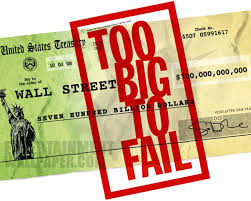In thinking about the JP Morgan Chase
situation, three problems come to mind immediately.
The first is the inability of the managements of these too-big-to-fail
institutions to fully comprehend and monitor what is going on.
The second is the inability of the regulators to fully comprehend what is going
on in an entity the size of JP Morgan Chase.
And third, and most importantly, these too-big-to-fail banks have short
institutional memories. They quickly forget what led to their problems the last
time it got tough for them. Eventually, they look to the US taxpayer for help
when the going is tough (whether in the form of direct assistance or, what we
have now, a near-zero interest rate environment to pad their profitability and
capital levels at the expense of savers who need a return on their deposits).
JPMC
and its likes (the too-big-to-fail banks) shouldn’t be allowed to act like
hedge funds (even though in the current instance the offending transactions
look more like bets than hedges against risk).
I keep seeing comments
from various commentators on various websites to the effect that JPMC should be
able to do what it likes with its “own” money. But this is either depositors'
funds or shareholders’ money (retained earnings). What should really happen
when JPMC has excess funds (i.e., those assets which aren't going be used to
facilitate the growth of the nation's economy through lending activities) is the
following: invest those excess funds temporarily in safe assets (US T-bills come to mind) until they can be deployed into loans or
distribute the portion of those funds which are retained earnings to the
shareholders who can then choose to invest in whatever asset classes they choose
under their own decision regimens. If hedge fund investments are what they
want, then let them make conscious decisions to invest in hedge funds, without
any Federal (US
taxpayer) guarantee of the investment.
But
here we are again with a too-big-to-fail bank losing $2+ billion of its “own”
money — and under the leadership of CEO Dimon who is one of those most vocal
against limiting the banks’ proprietary trading under proposed
regulation/legislation. What did CEO Dimon learn about risk management from our
most recent financial crisis? Nothing?
The
shareholders, bondholders and managers of these too-big-to-fail banks should
pay the price for “mistakes” such as JP Morgan Chase’s recent fiasco. However,
the US
taxpayer remains on the hook just as in the 2007-2008 financial crisis.
It’s
time we revisit the separation of real banking activity and everything else
that banks want to do. This might eliminate, or at least restrain, much of the
burden that is now placed on US taxpayers to correct the “sloppy” and “stupid”
decisions (CEO Dimon’s own adjectives) that have been made by the
too-big-to-fail banks in the post-Glass-Steagall era.
 |
IS TOO BIG TO
ALLOW!
|